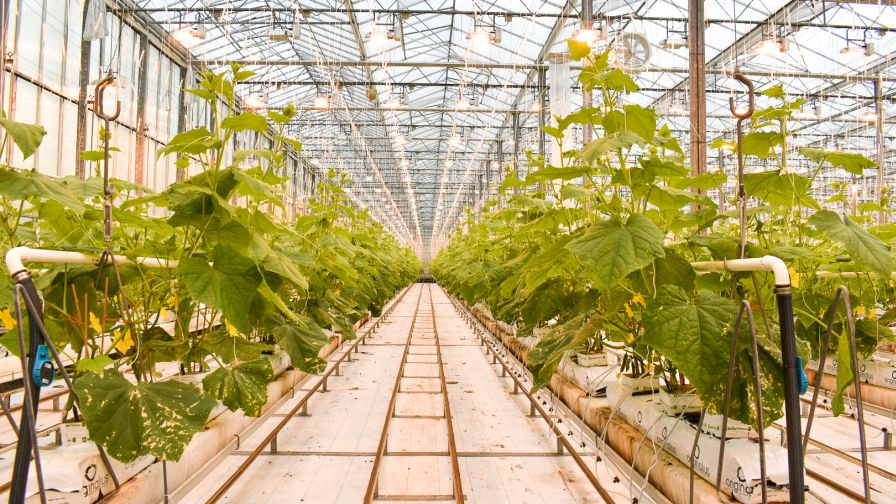Increased Demand Fueling Growth in Greenhouse Cucumbers

Bushel Boy Farms is now growing cucumbers on a little more than 3 acres at its Owatonna, MN, facility. Photo: Bushel Boy Farms
Bushel Boy Farms, headquartered in Owatonna, MN, with a second facility in Mason City, IA, is an experienced greenhouse tomato operation. However, the maturation of the tomato market has recently led the company to look for ways to diversify its crop mix. Starting this past year, Bushel Boy has expanded into greenhouse cucumbers at its Owatonna facility.
We recently reached out to Chuck Tryon, President of Bushel Boy Farms, to learn more about the changes the company had to make to accommodate cucumbers, the external forces shaping the cucumber market, and where he sees the market headed in the future.
Greenhouse Grower (GG): What made you decide to get into cucumber production, and how much are you producing right now?
Chuck Tryon: For 29 of our 32 years as a company, we only grew a couple varieties of tomatoes. However, over the last two to three years, we started looking at the potential for expansion. We started with increasing our tomato variety offering, then we took a turn and began growing strawberries. Then we started looking at other crops, with a focus on how we could grow within our existing system of high-tech glass greenhouses without making major infrastructure changes. Also, what could we pack for retailers that wouldn’t require a lot of additional changes?
Cucumbers fit the bill: like tomatoes, they are a high-wire crop, and they are relatively straightforward to pick and pack, so we wouldn’t have to make any operations changes. From a commercial perspective, the cucumber market is not as big as the tomato market, but we see it growing at a faster rate. A lot of that growth is coming from long English cucumbers, as well as smaller, mini cucumbers for snacking. Each of these fit very well for greenhouse production, and honestly anything in the snacking category has seen accelerated growth in the past couple years. In September, we started small by planting 1 acre, and by October we were selling the product. Since then, we’ve expanded into a little over 3 acres.
GG: Despite the parallels between tomatoes and cucumbers, I would imagine there was still a learning process. What did that involve?
Tryon: We started by working with seed companies to get their knowledge on the best growing practices to put in place. We also had the good fortune of having a grower on our team who, in a previous life, had experience growing cucumbers in a high-tech greenhouse environment. That gave us the confidence to move quickly because we knew we could minimize the unknowns, or react quickly to them.
There were some differences we saw, such as nutrient recipes. We also learned the new crops had different lighting and heating needs, and because we weren’t operating in a completely separate greenhouse, we had to compromise and figure out how to grow two different crops within one environment.
There was also the pollination challenge: in tomatoes, we utilize bumblebees for pollination. But our cucumber varieties are seedless and do not get pollinated, so we had to figure out a way to cordon off the bees. Unfortunately, bees are not good listeners, but we’ve figured out ways to keep them within one section of the greenhouse.
GG: What other crops are you looking at?
Tryon: There’s the usual suspects such as peppers, eggplants, and mini melons. If and when we do expand, we want to maintain our focus on vine crops that we are already set up to grow with minimal changes.
One thing we’ve definitely learned is that there’s value in having a diversified crop mix. Being able to rotate your product portfolio helps manage market fluctuations, and we think it’s a smart strategy for our business.
GG: What are the some of the broader external market forces that you see affecting future plans in cucumber production?
Tryon: We know tomatoes are a labor-intensive crop, and we’ve learned cucumbers are even more so because their rate of growth can sometimes require daily harvests. So our labor needs have increased, and we have to take that into consideration because of the cost and availability of labor today.
On the economic front, we’re monitoring how inflationary conditions are impacting our customers. Bushel Boy is a premium brand, which means our products are priced at a premium. At the same time, we understand the reality of consumers needing to stretch out their budget when shopping. We’re trying to be smart about managing our own cost structure so we can stay competitive, but we also know that changes in demand could impact our business.
From an energy cost standpoint, we’ve seen what’s been happening overseas with some operations limiting or even shutting down production. We’re frequently researching different methods of energy management and are prepared to make any necessary changes should we face these types of extreme situations.
Through all of this, our focus remains on being a local and regional producer. We want to continue providing fresh produce to consumers in the Midwest, especially as these consumers cont-
inue to have more interest in knowing where their food comes from. This will always be our goal, even as we navigate through some of these challenges.









